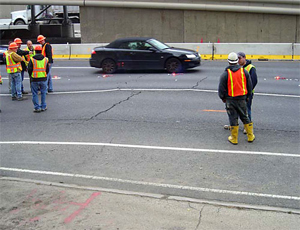More than seventeen years after the so-called Great Chicago Flood—a 1992 construction snafu in which a misplaced piling that was driven into the Chicago River hit an abandoned freight tunnel, flooding downtown basements and knocking out utilities—those infamous tunnels are at it again.
On Oct. 14, workers for Lorig Construction, a Des Plaines, Ill.-based roadbuilder, were preparing to finish grouting a section of old tunnels underneath the Kennedy Expressway, a busy segment of Interstate 90/94 that cuts through the city’s downtown. At about 10:05 a.m., a call from workers topside indicated that the pavement was buckling up about 9 in.
“Apparently, the grout was pushing against the ceiling, or migrated up,” says Jacek Tyszkiewicz, implementation engineer for Illinois Dept. of Transportation. The grout was intended as a preventive measure, as workers were about to drive H-piles nearby for a $9.3-million reconstruction of the highway’s deadly center ramps.
Called “suicide” ramps by the local motoring public and designed 50 years ago, the structures force drivers to merge onto the highway in the left lane. The nail-biting merges are a major source of accidents, IDOT says. The rebuild project involves ripping out some ramps to allow enough merge space for other ramps that will stay.
With a large “speed bump” developing on the eight-lane road, which handles up to 300,000 vehicles per day, IDOT shut down two outside lanes and the shoulder on the westbound side. Lorig sprang to work, saw-cutting pavement and removing 14 in. of material. It put down 4-in. of fresh stone and rebar before repaving.
The contractor then poured into the hole about 78 cu yd of “Type PP5,” quick-setting concrete for a patch measuring 39 ft wide, 54 ft long and 12 in. deep. The concrete was prepared on-site in a volumetric mixing truck (no time for batch-plant transit) and contained calcium aluminate. The chemical helps the material set up in 30 minutes and cure in about four hours. “Traditional concrete takes seven days to cure,” Tyszkiewicz says.
By 10:00 p.m., Lorig had placed the last batch, and by 3:00 a.m. the following morning, a plastic wrap came off the patch. The mix had achieved a flexural strength of 600 psi and compressive strength of 3,200 psi. The lanes reopened at 4:30 a.m.
With the bucking incident behind it, IDOT has launched an investigation into the cause of the grouting failure, which is still unknown. “We are going to look at a timeline,” says Tyszkiewicz. “It is going to be more of an empirical rather than a destructive thing.” IDOT has not yet determined total costs of the repair or who will pay for it.
Troubled Tunnels
The grouting project involved a high-slump, cementitious material, “like runny oatmeal,” Tyszkiewicz says. Lorig was placing it in three separate lifts to fill the old tunnels, located 15 ft below the roadbed and measuring about 6 ft wide and 7.5 ft tall with a pointed, arched roof. In all, IDOT filled 762 ft of tunnels, originally hand-dug a century ago for running underground electrical cables and supplying the city’s buildings with coal. Construction began in 1899, historians say, and the tunnels were abandoned in 1959. Under the Loop at an average of 40 ft below grade are no less than 60 mi of these single-track, electric-rail tunnels.
This month’s failure occurred in the final section of IDOT’s grouting project and on the third, final lift. The tunnel in question runs perpendicular to the freeway. Just prior to pumping in the grout, workers had installed a PVC vent with a ball valve that would have allowed the last bits of air to escape before the grout closed in on the bulkheads.
Just prior to the pavement heave, Lorig’s underground workers noticed that more grout than estimated was flowing in when they got the call from above that something was wrong. Ironically, lessons from the Great Chicago Flood were the reason behind the grouting program in the first place.
“We were being proactive,” Tyszkiewicz says. “We were worried that since the tunnels are basically a void, driving the piles near them would cause some problems.”
Update: Costs to repair the grout failure came to $70,000, says IDOT, which is paying for the work.



















Post a comment to this article
Report Abusive Comment